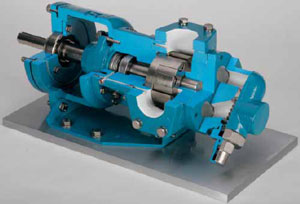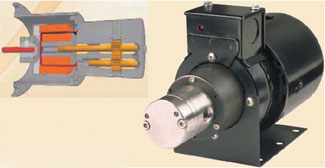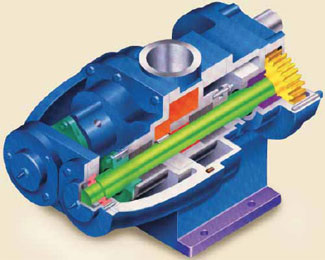Pumps & Systems, April 2008
Biodiesel is a relatively new industry. While the plants share a fundamentally similar process, they come in many different sizes, process variations and pumping needs and requirements. As with any new industry, there has been a learning curve to finding and adapting the best pump designs and technologies. A key to success is identifying all the needs of the application up front, and then selecting and sizing pumps that appropriately address those needs.
Biodiesel production starts with vegetable oil or rendered animal fats. Alcohol with a catalyst, usually sodium or potassium hydroxide, is mixed with the vegetable oil or fats. Glycerin is stripped off and created as a byproduct. Additional washing and purification steps are used, and the final product is fatty acid methyl esters, or biodiesel. Biodiesel systems providers and operators use enhancements and variations on the basic process to improve efficiency and to adapt to local conditions and feedstock sources.
Case Study

When building its Gordon, GA plant, Alterra Bioenergy sought pumps that would produce relatively constant flow, independent of viscosity changes and resulting variations in line losses. Some of the plant is located outdoors and unheated, and the ambient temperature may range from 0- to 100-deg F. The viscosity of vegetable oil will correspondingly range from about 125 centistokes at 0-deg F to 25 centistokes at 100-deg F. Variations in line losses can approach 50 percent over this range of viscosity.
Internal gear pumps were selected for the plant because the pumps could meet the requirement of constant flow delivery over the anticipated viscosity and line loss variations, and pumps were supplied within the time window necessary to support the schedule of bringing the plant into production. With a chilly winter season, the pumps had been tested on-and passed-the constant delivery requirement. Figure 1 (above) is a cutaway view of a typical pump used at the facility.
Other Pumps Available
Biodiesel plants and their pump applications come in many different sizes. Some biodiesel plants are small and fit modularly into the space of a truck trailer. These modular units may be used on a farm or military base with a source of feedstock and a fleet of vehicles to support with supplementary fuel.

Pumps for these modular units must be very compact, leak free and operate over the full range of thin water to thick feedstock. Miniature magnetically coupled external gear pumps can address these requirements. Figure 2 (left) shows internal and external views of a typical pump used in compact modular systems.
In larger systems, miniature magnetically coupled external gear pumps are used for dosing of sodium or potassium hydroxide, which are catalysts in the process. Potassium and sodium hydroxide are difficult to seal liquids. The leak free, sealless magnetically coupled designs, combined with the precise flow of the external gear design, can meet the challenges of potassium or sodium hydroxide dosing applications.
Some biodiesel plants are equipped to handle soy soap stock as a feedstock. Others separate the soap stock for processing at another location. Soy soap stock is a very challenging pumping application. Viscosity can range up to 25,000 centistokes, which can be gum like in consistency. Surges in viscous mass can cause pressure spikes. For this type of liquid, a proven technology is a circumferential piston pump with external bearing support on both sides of the impellers.

The circumferential piston pump performs well with viscous material. There is no metal-to-metal contact because the impellers intermesh without touching with the use of timing gears, and the pumping action is done with a fairly large open area in the pump. The use of external bearings makes the pump capable of handling up to 400 pounds per square inch of differential pressure, so the pump easily tolerates pressure spikes. Figure 3 (left) is a typical pump supplied for soy soap applications.
The key to success in selecting pumps for biodiesel production is understanding all the application and commercial requirements. The size and scale of the project, the environment in which the pumps operate, foot-print space available, seasonal variations, feedstock variations, unique process considerations and commercial requirements such as lead time all must be considered for successful biodiesel pump applications.


